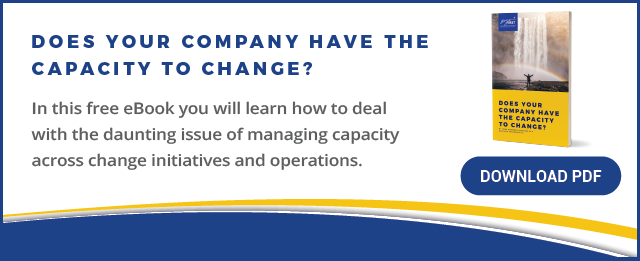As CEO, you know time is money. Most CEOs want organizational changes to go fast. Unfortunately, rushing things beyond what is reasonable, or needed, will end up costing you….in results, do-overs, and partial solutions that don’t fit the bill. One of our clients bemoaned to us, “We never have time to do it right. We always have time to do it over!” Does this ring true for your organization’s change track record?
An unrealistic timeline for a change initiative does nothing to increase its speed. In reality, it can slow things down because it drastically lowers the ability of your organization to change successfully while it continues to operate. It can produce a faulty solution and lower morale. You can impede the potential success of your change efforts by creating timelines that do not reflect the actual work and capacity required for them to be implemented. Just because you want the change to go fast does not mean it can go fast. It’s fine to create a sense of urgency for change, but that does not mean your timeline can be expedited beyond what is humanly possible.
The Impact of Unrealistic Project Timelines
When you establish timelines that do not mesh with the realities of the change or your organization, you lower your leadership credibility. Your people will see the discrepancy and you will lose their respect. You may also intimidate your managers who are afraid to confront the impossibility of what is being asked of them. Furthermore, the very people you need to make the change happen will begin to resist, resent, and fight the change because they feel victimized by its timeline, especially since they are likely rewarded for doing their normal work, not change work. Their stress will increase and they will begin to think that since the timeline is unrealistic, the change effort and its leadership are also unrealistic and out of touch with their reality.
Confronting the “Schedule Is King” Project Management Norm
Most organizations rely heavily on their Project Management approaches to change, which typically starts every project with decisions about “scope, schedule, budget.” Of course you need this information to manage a project. However, determining these three critical decisions before you have investigated the type and magnitude of change sets the “Schedule is King” pattern in motion. If you do not know what the solution will entail, and how much disruption it will cause your operation, you cannot predict the timeline it will require to be implemented and sustained successfully. Most unrealistic timelines come from this way of launching projects. Many come from external consultants who promise to get the change deployed quickly and do not account for the very human factors that impact their ability to do so. Then it’s your people who suffer, while your consultants “do it to them.” Don’t make this mistake.
What Factors Determine the Speed of an Organizational Change Initiative?
The speed at which you can design and implement a change initiative is a product of several variables:
- The complexity and magnitude of change required (especially if it is transformational)
- The change readiness, capacity, and capability of your organization to take on the new solution
- The resources you have allocated to the entire process, including post-deployment support
- The efficiency of your current operations
- The degree of attention required to change the organization’s culture and people’s mindsets and behavior
- Your recent change history…easy, successful, or very challenging!
All mixed together with a healthy dose of operational reality, these variables influence the determination of timeline. Your change could go faster if it was less complex, your organization was more change-ready, had more time, or had more change skill. Or if you allocated more resources and your workforce was unified, excited and committed to making this change. But each variable is what it is right now, and the mix of them all are the factors that determine the speed possible now.
Set the expectation for realistic timelines for your change initiatives. Stop using arbitrary timelines that do not match the real needs of your change efforts or the readiness and capacity of your organization to make the changes happen. Do this and you will enhance your leadership credibility, guaranteed.


